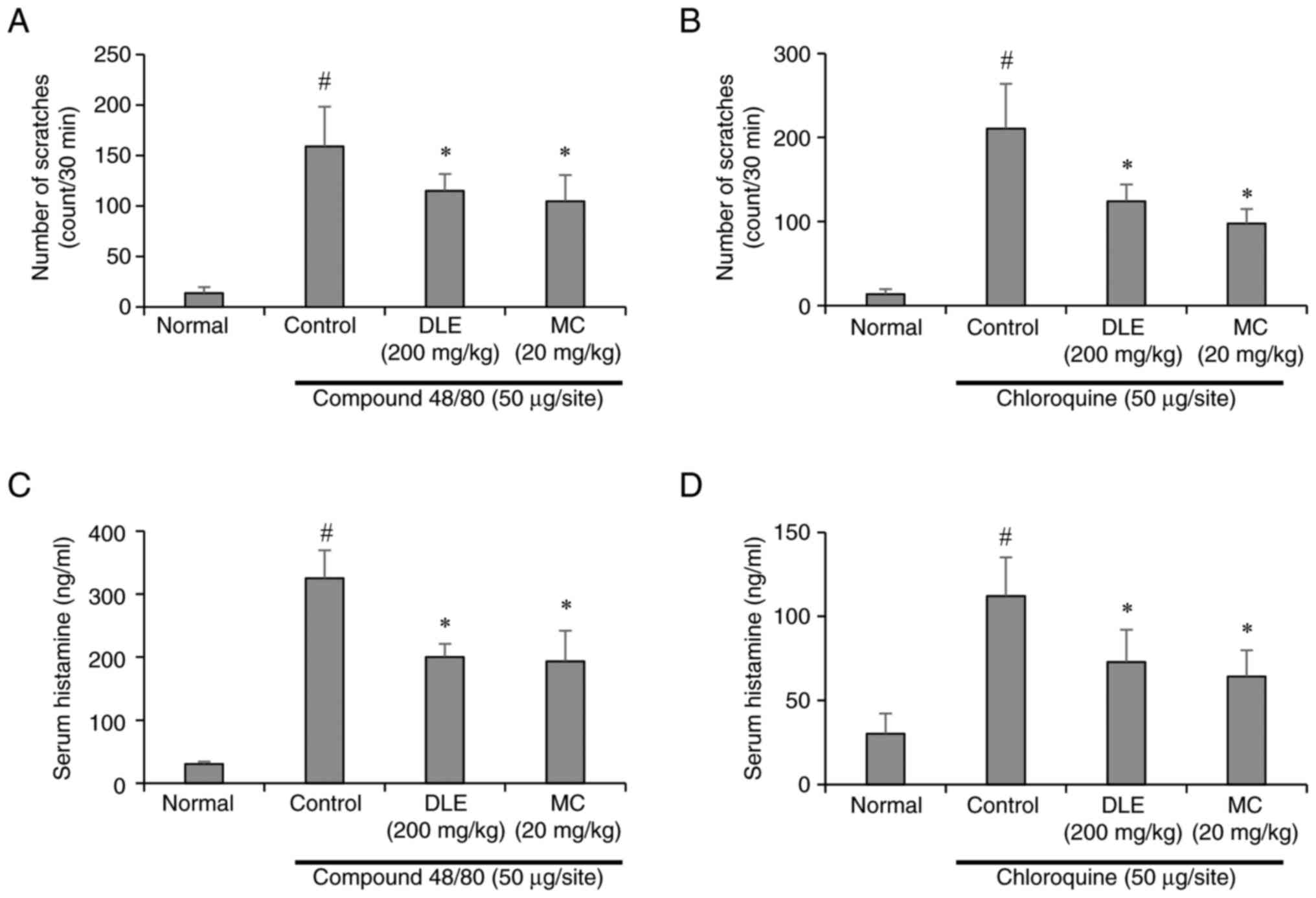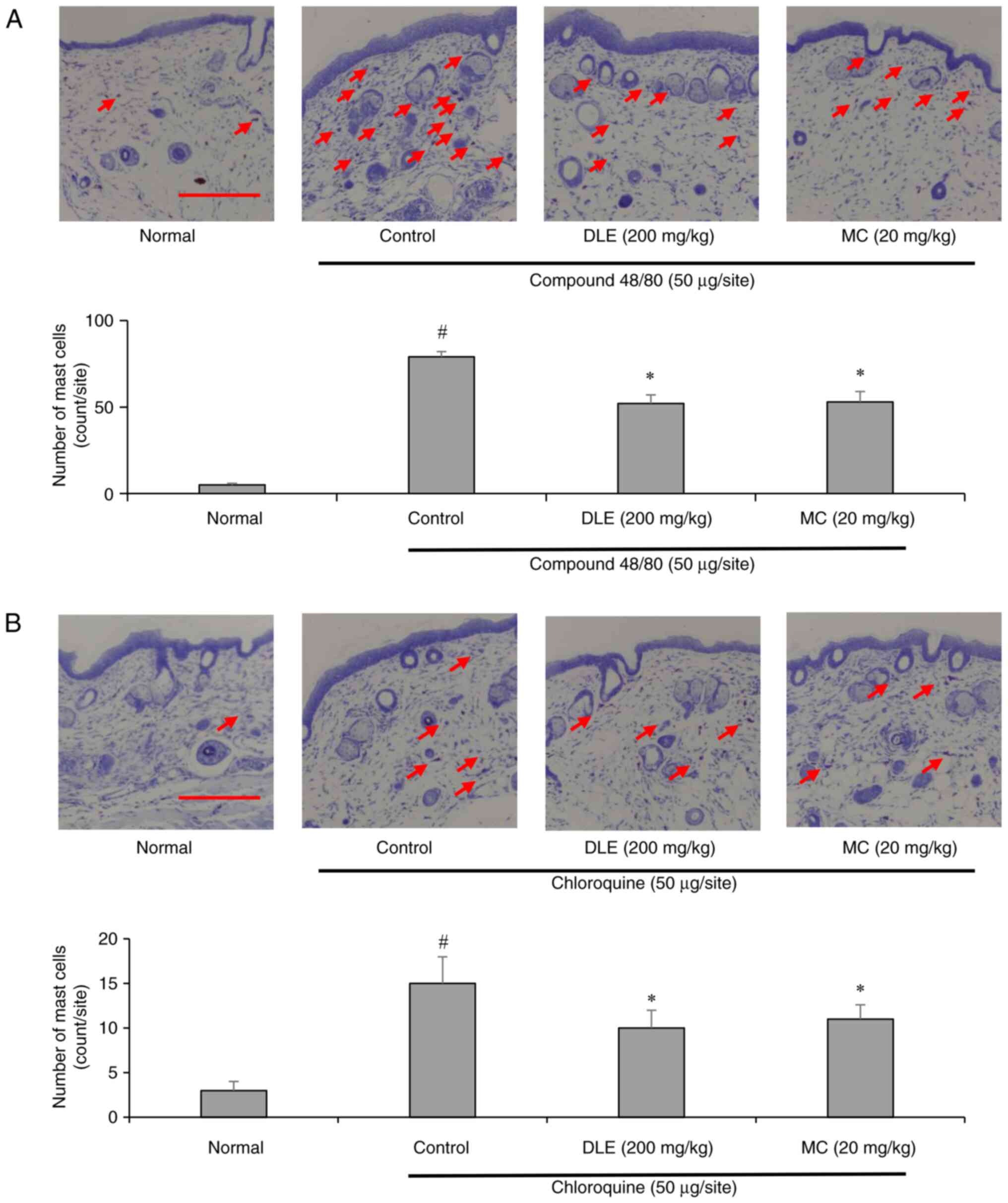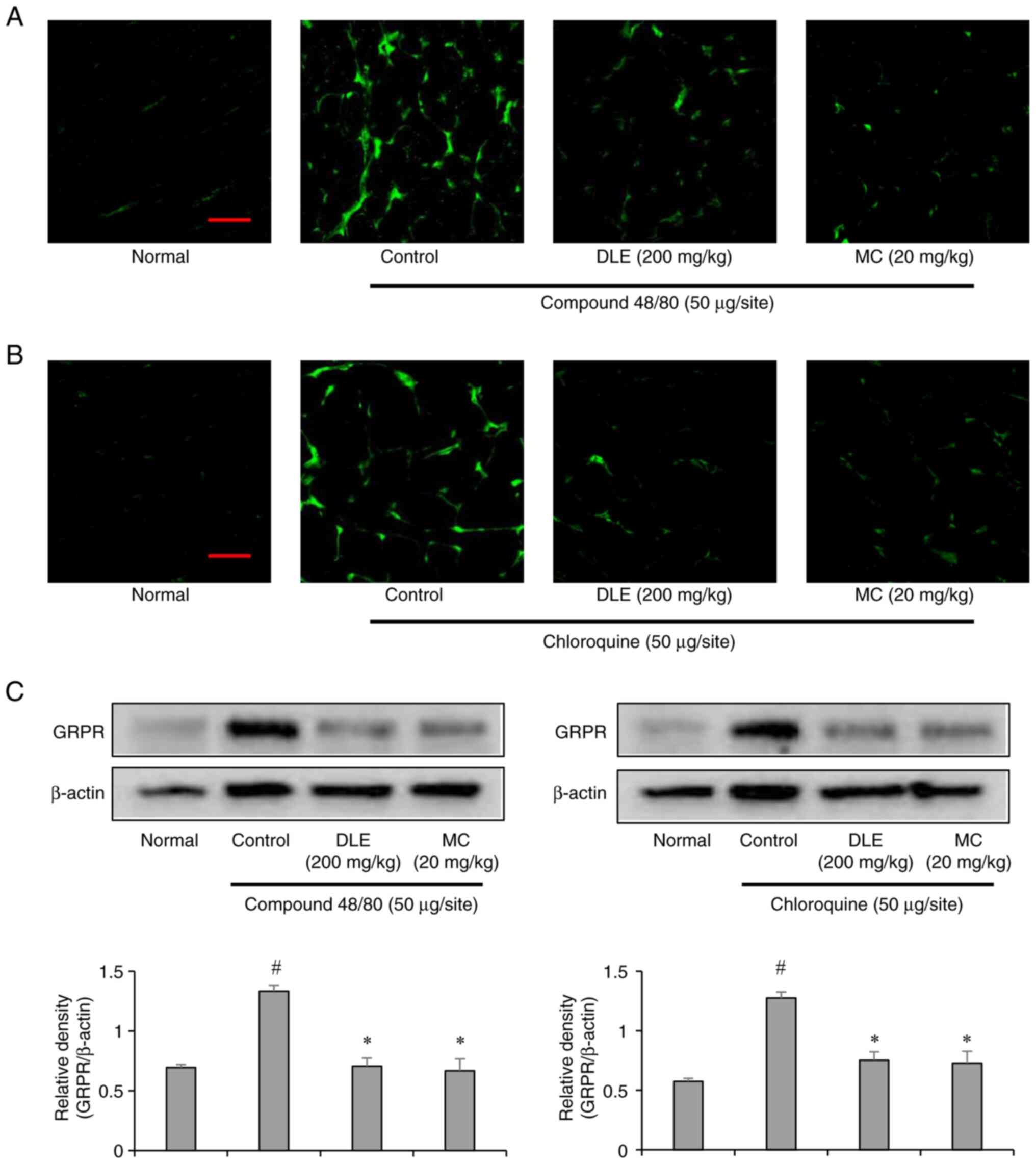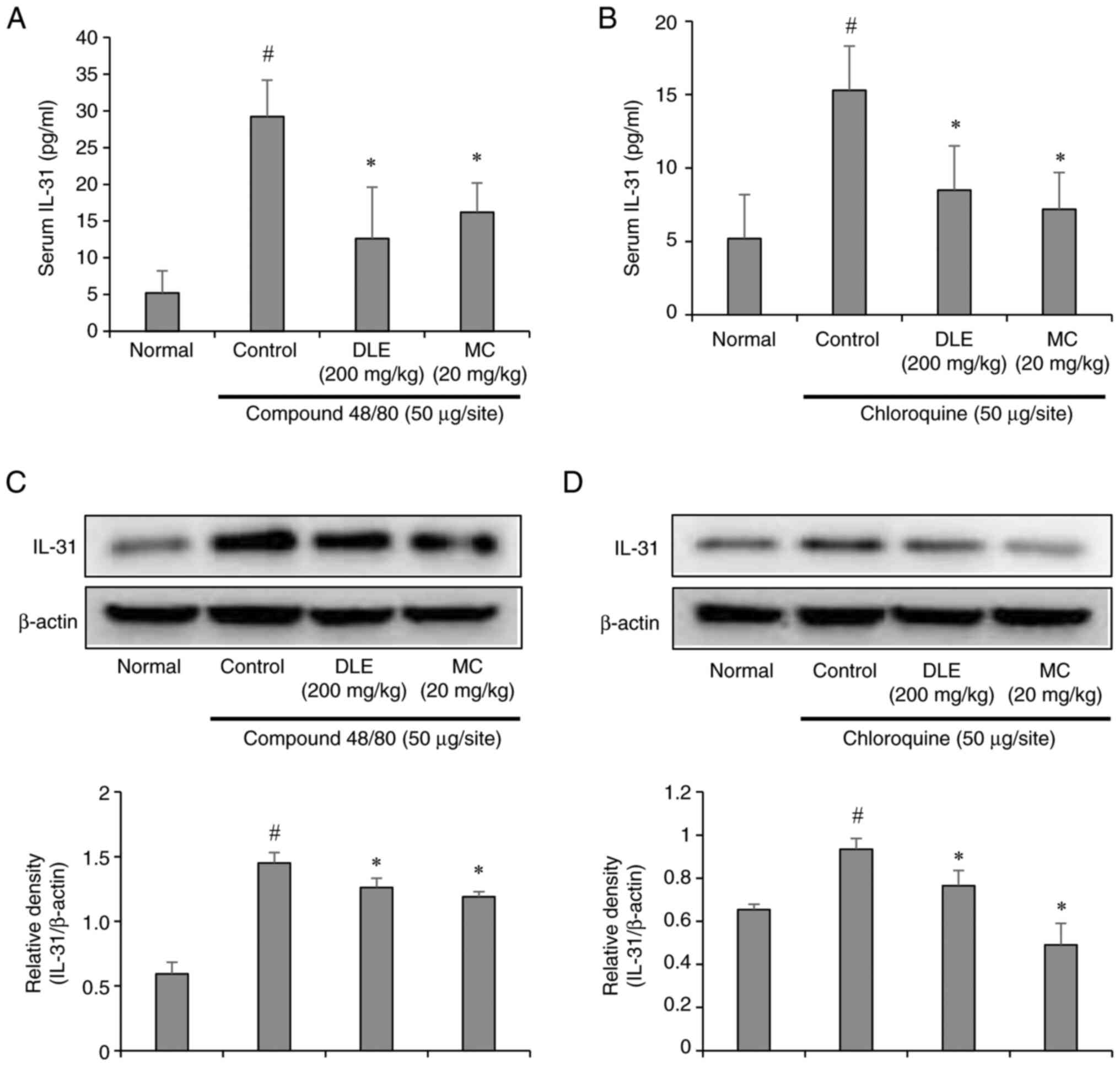|
1
|
Bourane S, Duan B, Koch SC, Dalet A, Britz
O, Garcia-Campmany L, Kim E, Cheng L, Ghosh A, Ma Q and Goulding M:
Gate control of mechanical itch by a subpopulation of spinal cord
interneurons. Science. 350:550–554. 2015.PubMed/NCBI View Article : Google Scholar
|
|
2
|
Krajnik M and Zylicz Z: Understanding
pruritus in systemic disease. J Pain Symptom Manage. 21:151–168.
2001.PubMed/NCBI View Article : Google Scholar
|
|
3
|
Ständer S, Zeidler C, Magnolo N, Raap U,
Mettang T, Kremer AE, Weisshaar E and Augustin M: Clinical
management of pruritus. J Dtsch Dermatol Ges. 13:101–116.
2015.PubMed/NCBI View Article : Google Scholar : (In English,
German).
|
|
4
|
Lyell A: The itching patient. A review of
the causes of pruritus. Scott Med J. 17:334–347. 1972.PubMed/NCBI View Article : Google Scholar
|
|
5
|
Song J, Xian D, Yang L, Xiong X, Lai R and
Zhong J: Pruritus: Progress toward pathogenesis and treatment.
Biomed Res Int. 2018(9625936)2018.PubMed/NCBI View Article : Google Scholar
|
|
6
|
Wang F, Yang TLB and Kim BS: The return of
the mast cell: New roles in neuroimmune itch biology. J Invest
Dermatol. 140:945–951. 2020.PubMed/NCBI View Article : Google Scholar
|
|
7
|
Amin K: The role of mast cells in allergic
inflammation. Respir Med. 106:9–14. 2012.PubMed/NCBI View Article : Google Scholar
|
|
8
|
Haugen HF and Skrede S: Nucleotide
pyrophosphatase and phosphodiesterase I. Demonstration of activity
in normal serum, and an increase in cholestatic liver disease.
Scand J Gastroenterol. 11:121–127. 1976.PubMed/NCBI
|
|
9
|
Sugimoto Y, Umakoshi K, Nojiri N and Kamei
C: Effects of histamine H1 receptor antagonists on compound
48/80-induced scratching behavior in mice. Eur J Pharmacol.
351:1–5. 1998.PubMed/NCBI View Article : Google Scholar
|
|
10
|
Mießner H, Seidel J and Smith ESJ: In
vitro models for investigating itch. Front Mol Neurosci.
15(984126)2022.PubMed/NCBI View Article : Google Scholar
|
|
11
|
Yosipovitch G, Rosen JD and Hashimoto T:
Itch: From mechanism to (novel) therapeutic approaches. J Allergy
Clin Immunol. 142:1375–1390. 2018.PubMed/NCBI View Article : Google Scholar
|
|
12
|
Ma Q: Labeled lines meet and talk:
Population coding of somatic sensations. J Clin Invest.
120:3773–3778. 2010.PubMed/NCBI View
Article : Google Scholar
|
|
13
|
Mishra SK and Hoon MA: Transmission of
pruriceptive signals. In: Pharmacology of Itch. Cowan A and
Yosipovitch G (eds) Vol 226. Springer Berlin Heidelberg, Berlin,
Heidelberg, pp151-162, 2015.
|
|
14
|
Sun YG and Chen ZF: A gastrin-releasing
peptide receptor mediates the itch sensation in the spinal cord.
Nature. 448:700–703. 2007.PubMed/NCBI View Article : Google Scholar
|
|
15
|
Liu Q, Tang Z, Surdenikova L, Kim S, Patel
KN, Kim A, Ru F, Guan Y, Weng HJ, Geng Y, et al: Sensory
neuron-specific GPCR Mrgprs are itch receptors mediating
chloroquine-induced pruritus. Cell. 139:1353–1365. 2009.PubMed/NCBI View Article : Google Scholar
|
|
16
|
Mnyika KS and Kihamia CM:
Chloroquine-induced pruritus: Its impact on chloroquine utilization
in malaria control in Dar es Salaam. J Trop Med Hyg. 94:27–31.
1991.PubMed/NCBI
|
|
17
|
Rauf A, Uddin G, Patel S, Khan A, Halim
SA, Bawazeer S, Ahmad K, Muhammad N and Mubarak MS: Diospyros, an
under-utilized, multi-purpose plant genus: A review. Biomed
Pharmacother. 91:714–730. 2017.PubMed/NCBI View Article : Google Scholar
|
|
18
|
Cho BO, Yin HH, Fang CZ, Kim SJ, Jeong SI
and Jang SI: Hepatoprotective effect of Diospyros lotus leaf
extract against acetaminophen-induced acute liver injury in mice.
Food Sci Biotechnol. 24:2205–2212. 2015.
|
|
19
|
Kim BM, Cho BO and Jang SI: Anti-obesity
effects of Diospyros lotus leaf extract in mice with
high-fat diet-induced obesity. Int J Mol Med. 43:603–613.
2019.PubMed/NCBI View Article : Google Scholar
|
|
20
|
Cho BO, Che DN, Shin JY, Kang HJ, Kim JH,
Kim HY, Cho WG and Jang SI: Ameliorative effects of Diospyros
lotus leaf extract against UVB-induced skin damage in BALB/c
mice. Biomed Pharmacother. 95:264–274. 2017.PubMed/NCBI View Article : Google Scholar
|
|
21
|
Cho BO, Che DN, Yin HH, Shin JY and Jang
SI: Diospyros lotus leaf and grapefruit stem extract
synergistically ameliorate atopic dermatitis-like skin lesion in
mice by suppressing infiltration of mast cells in skin lesions.
Biomed Pharmacother. 89:819–826. 2017.PubMed/NCBI View Article : Google Scholar
|
|
22
|
Shin JY, Cho BO, Park JH, Kang ES, Kim YS
and Jang SI: Diospyros lotus leaf extract and its main
component myricitrin regulate pruritus through the inhibition of
astrocyte activation. Exp Ther Med. 26(323)2023.PubMed/NCBI View Article : Google Scholar
|
|
23
|
Kwiatkowska D and Reich A: Role of mast
cells in the pathogenesis of pruritus in mastocytosis. Acta Derm
Venereol. 101(adv00583)2021.PubMed/NCBI View Article : Google Scholar
|
|
24
|
Barry DM, Liu XT, Liu B, Liu XY, Gao F,
Zeng X, Liu J, Yang Q, Wilhelm S, Yin J, et al: Exploration of
sensory and spinal neurons expressing gastrin-releasing peptide in
itch and pain related behaviors. Nat Commun.
11(1397)2020.PubMed/NCBI View Article : Google Scholar
|
|
25
|
Datsi A, Steinhoff M, Ahmad F, Alam M and
Buddenkotte J: Interleukin-31: The ‘itchy’ cytokine in inflammation
and therapy. Allergy. 76:2982–2997. 2021.PubMed/NCBI View Article : Google Scholar
|
|
26
|
Shiratori-Hayashi M, Yamaguchi C, Eguchi
K, Shiraishi Y, Kohno K, Mikoshiba K, Inoue K, Nishida M and Tsuda
M: Astrocytic STAT3 activation and chronic itch require
IP3R1/TRPC-dependent Ca2+ signals in mice. J Allergy
Clin Immunol. 147:1341–1353. 2021.PubMed/NCBI View Article : Google Scholar
|
|
27
|
Steinhoff M, Ahmad F, Pandey A, Datsi A,
AlHammadi A, Al-Khawaga S, Al-Malki A, Meng J, Alam M and
Buddenkotte J: Neuroimmune communication regulating pruritus in
atopic dermatitis. J Allergy Clin Immunol. 149:1875–1898.
2022.PubMed/NCBI View Article : Google Scholar
|
|
28
|
Di Salvo E, Gangemi S, Genovese C, Cicero
N and Casciaro M: Polyphenols from mediterranean plants: Biological
activities for skin photoprotection in atopic dermatitis,
psoriasis, and chronic urticaria. Plants (Basel).
12(3579)2023.PubMed/NCBI View Article : Google Scholar
|
|
29
|
Kaag S and Lorentz A: Effects of dietary
components on mast cells: Possible use as nutraceuticals for
allergies? Cells. 12(2602)2023.PubMed/NCBI View Article : Google Scholar
|
|
30
|
Perrelli A, Goitre L, Salzano AM, Moglia
A, Scaloni A and Retta SF: Biological activities, health benefits,
and therapeutic properties of avenanthramides: from skin protection
to prevention and treatment of cerebrovascular diseases. Oxid Med
Cell Longev. 2018(6015351)2018.PubMed/NCBI View Article : Google Scholar
|
|
31
|
Mwakalukwa R, Ashour A, Amen Y, Niwa Y,
Tamrakar S, Miyamoto T and Shimizu K: Anti-allergic activity of
polyphenolic compounds isolated from olive mill wastes. J Funct
Foods. 58:207–217. 2019.
|
|
32
|
Ortiz-Cerda T, Argüelles-Arias F,
Macías-García L, Vázquez-Román V, Tapia G, Xie K, García-García MD,
Merinero M, García-Montes JM, Alcudia A, et al: Effects of
polyphenolic maqui (Aristotelia chilensis) extract on the
inhibition of NLRP3 inflammasome and activation of mast cells in a
mouse model of Crohn's disease-like colitis. Front Immunol.
14(1229767)2024.PubMed/NCBI View Article : Google Scholar
|
|
33
|
Shaik Y, Caraffa A, Ronconi G, Lessiani G
and Conti P: Impact of polyphenols on mast cells with special
emphasis on the effect of quercetin and luteolin. Cent Eur J
Immunol. 43:476–481. 2018.PubMed/NCBI View Article : Google Scholar
|
|
34
|
Vo TS, Le TT, Kim S and Ngo D: The role of
myricetin from Rhodomyrtus tomentosa (Aiton) Hassk fruits on
downregulation of FcɛRI-mediated mast cell activation. J Food
Biochem. 44(e13143)2020.PubMed/NCBI View Article : Google Scholar
|
|
35
|
Trier AM and Kim BS: Cytokine modulation
of atopic itch. Curr Opin Immunol. 54:7–12. 2018.PubMed/NCBI View Article : Google Scholar
|
|
36
|
Shin JY, Cho BO, Park JH, Kang ES, Kim JH,
Ha HY, Kim YS and Jang SI: Diospyros lotus leaf extract and
its main component myricitrin inhibit itch-related IL-6 and IL-31
by suppressing microglial inflammation and microglial-mediated
astrocyte activation. Mol Med Rep. 30(178)2024.PubMed/NCBI View Article : Google Scholar
|
|
37
|
Tsuda M: Spinal dorsal horn astrocytes:
New players in chronic itch. Allergol Int. 66:31–35.
2017.PubMed/NCBI View Article : Google Scholar
|
|
38
|
Aziz MdA, Sarwar MdS, Akter T, Uddin MS,
Xun S, Zhu Y, Islam MS and Hongjie Z: Polyphenolic molecules
targeting STAT3 pathway for the treatment of cancer. Life Sci.
268(118999)2021.PubMed/NCBI View Article : Google Scholar
|
|
39
|
Yin Q, Wang L, Yu H, Chen D, Zhu W and Sun
C: Pharmacological effects of polyphenol phytochemicals on the
JAK-STAT signaling pathway. Front Pharmacol.
12(716672)2021.PubMed/NCBI View Article : Google Scholar
|




















